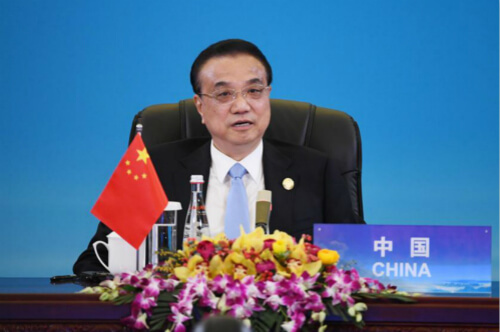
在第八次中日韩领导人会议上的讲话文章源自英文巴士-https://www.en84.com/8529.html
Remarks at the Eighth Trilateral Summit Meeting Among the People’s Republic of China, the Republic of Korea and Japan文章源自英文巴士-https://www.en84.com/8529.html
文章源自英文巴士-https://www.en84.com/8529.html
中华人民共和国国务院总理 李克强文章源自英文巴士-https://www.en84.com/8529.html
H.E. Li Keqiang, Premier of the State Council of the People’s Republic of China文章源自英文巴士-https://www.en84.com/8529.html
文章源自英文巴士-https://www.en84.com/8529.html
2019年12月24日,成都文章源自英文巴士-https://www.en84.com/8529.html
Chengdu, 24 December 2019文章源自英文巴士-https://www.en84.com/8529.html
文章源自英文巴士-https://www.en84.com/8529.html
文在寅总统,文章源自英文巴士-https://www.en84.com/8529.html
安倍晋三首相:
President Moon Jae-in,
Prime Minister Shinzo Abe,
欢迎你们来到成都出席第八次中日韩领导人会议。成都是一个古老而现代的城市,不仅拥有着深厚的历史文化积淀,而且是中国西南地区创新和开放重镇。《三国演义》里蜀国的精彩故事、旅居成都多年的唐代“诗圣”杜甫在韩、日为人熟知,韩、日两国僧侣也曾在这里留下求法修行的足迹。
Let me welcome both of you to Chengdu for the eighth Trilateral Summit Meeting. Chengdu is an ancient yet modern city, a historical town with rich cultural heritage, and a front-runner in innovation and opening-up in Southwest China. It is where the intriguing stories of the Kingdom of Shu (A.D. 221-263) in the Romance of the Three Kingdoms took place. And Poet Du Fu (A.D. 712-770) of the Tang Dynasty, known as “Sage of Poetry”, lived here for many years. I understand both these episodes are well-known to many in the ROK and Japan. Historical anecdotes also show that Korean and Japanese monks traveled to Chengdu on religious pilgrimages centuries ago.
今年适逢中日韩合作20周年。20年前,为应对亚洲金融危机带来的挑战,三国领导人在马尼拉东亚合作领导人系列会议期间举行非正式会晤,栽下中日韩合作的幼苗。20年后,通过三国共同培育,中日韩合作已成长为一棵枝繁叶茂的大树。三国建立了以领导人会议为中心、21个部长级会议为主体、中日韩合作秘书处等为支撑的全方位合作体系。务实合作涵盖经贸、交通、信息、海关、环境、科技、农林等近30个领域。2018年三国间贸易总额达到7200亿美元,相互间投资额接近120亿美元。人文交流日益密切,2018年人员往来超过3000万人次,相互理解和认知不断加深。中日韩合作为三国各自发展提供了重要助力,为企业界和民众带来越来越多的商机和实惠,符合三国共同利益。
This year marks the 20th anniversary of the trilateral cooperation. The seedling of this cooperation was planted two decades ago in the aftermath of the Asian financial crisis when leaders of our three countries held an informal meeting on the sidelines of the East Asian leaders’ meetings in Manila. Twenty years on, the trilateral cooperation has grown into a lush tree thanks to the joint efforts of the three countries.
We have put in place an all-dimensional cooperation framework centering on the summit meeting, comprising 21 ministerial meetings and supported by the Trilateral Cooperation Secretariat (TCS). Our practical cooperation covers nearly 30 fields, from economy, trade, transportation, information and telecommunication, customs, to the environment, science and technology, agriculture and forestry. Last year, trilateral trade reached US$720 billion, and investment approached US$12 billion. Our people enjoy ever closer ties, with over 30 million visits exchanged last year. Mutual knowledge and understanding among us have increased.
The trilateral cooperation has bolstered our respective development and brought increasing business opportunities and real benefits to our companies and our people. It has well served the common interests of all our countries.
各位同事!
Colleagues,
当前,国际形势正在发生复杂深刻变化,地缘政治冲突和热点问题此起彼伏,不稳定不确定因素明显增多。世界经济和贸易增速放缓,主要经济体普遍面临经济下行压力,保护主义、单边主义蔓延,全球产业链和国际分工体系受到严重冲击,需要各国共同应对。在第二届中国国际进口博览会上,中国国家主席习近平提出共建开放合作、开放创新、开放共享的世界经济。中日韩作为东亚经济的中坚力量和区域合作的主要推动力量,应进一步加强紧密合作,发扬同舟共济精神,在保持各自发展上升势头的同时,坚定支持多边主义和自由贸易,继续推进区域经济一体化进程。
We are meeting at a time of complex and profound changes in the international landscape. Geopolitical conflicts and hotspot issues keep flaring up amid mounting uncertainties and destabilizing factors. Slowing global growth and trade have put many major economies under downward pressure. Rising protectionism and unilateralism have seriously affected the global industrial chain and international division of labor. These challenges require collective responses from all countries.
At the second China International Import Expo, President Xi Jinping called for joint efforts to build an open world economy through cooperation, with innovation and for mutual benefits. Our three countries, as the powerhouse of the East Asian economy and a major driver of regional cooperation, must step up cooperation in a spirit of mutual help and partnership. While sustaining the momentum of our respective development, we must stand firmly by multilateralism and free trade, and move forward regional economic integration.
第一,要共同维护地区和平稳定。就本地区而言,朝鲜半岛形势广受关注。实现半岛无核化、建立和平机制符合三国的共同利益,三国要发挥各自优势,加强协调配合,按照“双轨并进”思路和分阶段、同步走的原则,妥善处理各方合理关切,努力寻找弥合分歧的途径,推动有关方面对话取得进展,最终实现本地区长治久安。
First, we need to jointly safeguard regional peace and stability. The situation on the Korean Peninsula has been a focus of attention. Realizing denuclearization and establishing a peace mechanism on the Peninsula is in the interest of all three countries. We need to leverage our respective strengths and intensify coordination and collaboration. Guided by the “dual-track approach” and the principle of “phased and synchronized progress”, we need to properly address the legitimate concerns of all parties, identify ways for bridging differences, and facilitate progress in the talks between relevant parties, with a view to ultimately achieving enduring peace and security of our region.
第二,要共同践行新的安全理念。当前恐怖主义、网络安全、气候变化、重大传染疾病等非传统安全挑战日益严峻,与地缘政治和地区热点等传统安全问题相互交织,使安全形势呈现出多样性、突发性、跨国性和联动性特点。当人类面临的安全挑战突破主权边界、以非传统方式在全球范围扩散时,任何国家都难以独善其身、独自解决。我们必须坚持共同、综合、合作、可持续的新安全观,基于共同安全利益,追求本地区的整体安全。国家间加强安全合作不应针对第三方,不应影响地区稳定。
Second, we need to jointly apply a new vision of security. Our world is confronted with growing non-traditional security challenges, such as terrorism, cybersecurity, climate change and major infectious diseases. These have become interwoven with traditional security threats brought by geopolitical tensions and regional hotspots, leading to a complex, volatile security situation prone to varied and interconnected challenges.
As the security challenges confronting humanity defy sovereign boundaries and proliferate worldwide in unconventional ways, no country can stay immune from their impacts or tackle them all by itself. We need to follow a new vision of common, comprehensive, cooperative and sustainable security, and work for the security of the whole region proceeding from our common security interests. Moves to enhance security cooperation should neither target third parties nor undermine regional stability.
第三,要共同坚持开放包容。在经济全球化深入发展的今天,世界需要的是开放而不是壁垒,是合作而不是“脱钩”。人类同处一个地球村,各国命运休戚与共,应秉持相互尊重、公平正义、合作共赢的原则,推动建设新型国际关系,推动构建人类命运共同体。中方共建“一带一路”的倡议是属于世界的合作平台,倡导和平合作、开放包容、互学互鉴、互利共赢,为推动亚洲和世界经济增长开辟了新空间,欢迎韩、日积极参与。
Third, we need to jointly pursue openness and inclusiveness. In this increasingly globalized world, we need openness, not barriers; and we need cooperation, not “decoupling”. We live in the same global village where our futures are interlinked. We need to build a new type of international relations and a community with a shared future for mankind in keeping with the principles of mutual respect, fairness, justice and win-win cooperation.
China’s Belt and Road Initiative is a cooperation platform that belongs to the world. It advocates peace and cooperation, openness and inclusiveness, mutual learning and mutual benefit, and has opened up new space for the growth of Asia and the world. China welcomes the active participation of the ROK and Japan in this initiative.
第四,要共同引领区域合作。中日韩总人口16亿、占东亚70%,经济总量近21万亿美元、占东亚近90%,应担负起带动地区共同发展繁荣的重任。三国要加强在东盟与中日韩、东亚峰会、东盟地区论坛和湄公河次区域合作中的协调配合,引领区域合作聚焦东亚、聚焦发展,维护和完善东亚现有区域合作架构,使之更符合地区国家需要。
Fourth, we need to jointly drive regional cooperation. Our three countries have a combined population of 1.6 billion accounting for 70 percent of East Asia’s total; and our economies, with an aggregate GDP of nearly US$21 trillion, take up nearly 90 percent of the East Asian economy. It is thus incumbent upon us to shoulder the important task of facilitating shared progress and prosperity of our region.
We need to strengthen coordination and collaboration under the frameworks of ASEAN Plus Three, the East Asia Summit, the ASEAN Regional Forum and the Mekong sub-regional cooperation. We need to keep the focus of regional cooperation on East Asia and on development, and preserve and improve the existing East Asian cooperation architecture to better serve the needs of countries in this region.

